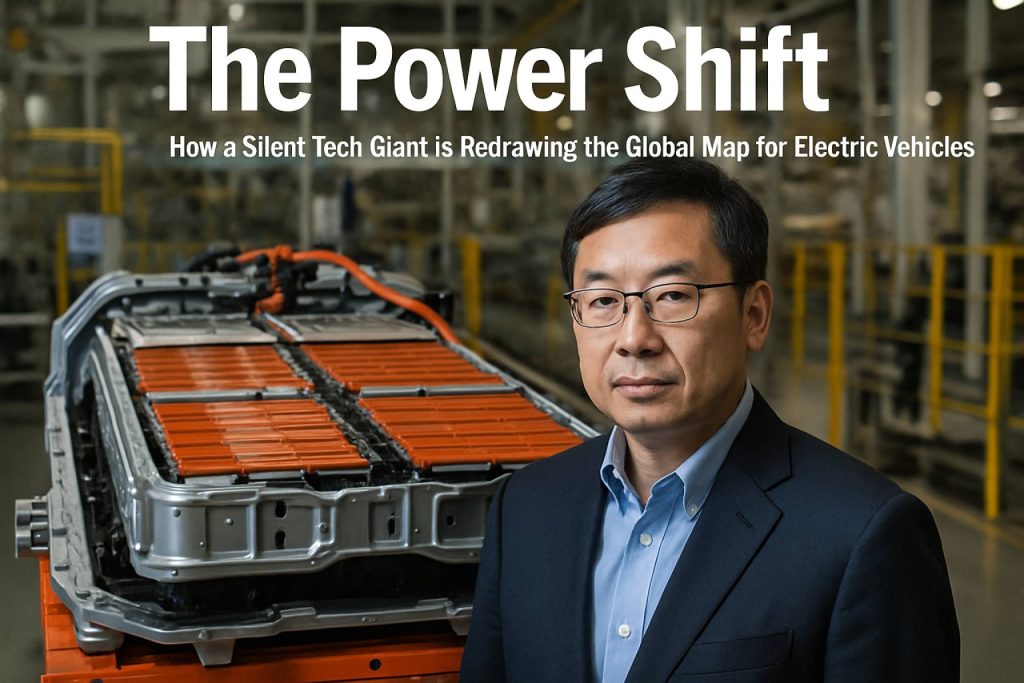
- CATL stunned global finance with a record-breaking $4.6 billion IPO, surging 16% on its Hong Kong debut and boasting a $130 billion+ market value.
- The company supplies over one-third of all electric vehicle batteries worldwide, powering leading brands like Tesla, Volkswagen, Toyota, Ford, and Mercedes-Benz.
- CATL’s dual stock listing in Shenzhen and Hong Kong marks a bold move toward global market dominance amid fierce competition from LG Energy Solution and Panasonic.
- Innovations include lighter, faster-charging batteries, increased range, and grid-scale energy storage solutions, supported by six international R&D centers and 13 factories.
- Challenges remain due to geopolitical tensions, trade restrictions, and security concerns in Western markets, but surging profits reflect growing global demand for clean energy technology.
Sparks fly in the global finance world as an electric vehicle battery giant captures the spotlight. Across Hong Kong, digital tickers flashed and the mood in trading rooms jumped, all set off by Contemporary Amperex Technology Co., Ltd. — better known as CATL — whose debut electrified the stock exchange, surging shares 16% and pulling in a staggering $4.6 billion. Now towering above its rivals, CATL claims this year’s largest initial public offering, issuing a thunderous challenge from the heart of China to the entire financial world.
With its commanding market value exceeding $130 billion, CATL is not just any tech company. The firm counts over one-third of all EV batteries sold globally as its own, powering everything from city buses in Oslo to cutting-edge sedans rolling off Silicon Valley assembly lines. Their battery packs already pulse within the chassis of icons like Tesla, Volkswagen, Mercedes-Benz, Toyota, and Ford. Imagine the lifeblood of the world’s greenest cars—CATL supplies it.
The company’s dual listing, now spanning both Shenzhen and Hong Kong, signals more than financial ambition. It’s a bold statement: CATL is setting its sights on the global stage. Competition has stiffened — Korean powerhouse LG Energy Solution and Japan’s Panasonic loom large, while Western markets grow increasingly nervy over China’s technological dominance and questions swirl around supply chains and national security.
But this is more than a story about numbers and IPOs. The real drama unfolds in research labs and on factory floors. CATL’s latest ambitions border on science fiction: lighter batteries with faster recharge times, greater cold resilience, cheaper production, and extended range. Its research centers — six in all, from Germany to Shanghai — hum with the restless efforts of over 100,000 employees and 13 sprawling production plants. This workforce isn’t only fueling the next wave of electric vehicles; they’re crafting giant batteries for power grids, aiming to store renewable energy on a scale that could transform entire countries’ infrastructure.
Not every move draws applause. Fierce geopolitical tensions, trade restrictions, and tit-for-tat tariffs complicate CATL’s global leap, especially as U.S. regulators place the company under increased scrutiny and block American investors from its Hong Kong sale. CATL’s leaders call the security allegations unfounded — a new kind of Cold War is playing out at the intersection of technology and national security.
Despite the diplomatic earthquakes, CATL’s numbers soar. The beginning of 2025 saw the company’s profit balloon by 30%, riding a worldwide wave of electric vehicle adoption. Global consumers hunger for cleaner cars and cheaper energy – and CATL is betting its future that the world is ready to follow.
Key takeaway: CATL isn’t just fueling electric vehicles — it’s rewriting the playbook for global energy, technology, and finance. The battery revolution is here, and at its heart lies a Chinese giant dead-set on electrifying the entire planet.
CATL’s Global Battery Dominance: Secrets Behind the Electric Revolution & What You Need to Know
Unpacking CATL’s Meteoric Rise: Beyond the Headlines
Contemporary Amperex Technology Co., Ltd. (CATL) is making global waves after a record-shattering $4.6 billion IPO debut in Hong Kong. What’s fueling this powerhouse’s ascent, and what does it mean for the future of electric vehicles, renewable energy, and global markets? Let’s dig deep—with expert-verified details and valuable takeaways.
—
1. How Did CATL Become the World’s Top EV Battery Supplier?
Insider Fact:
CATL supplies batteries to one in three electric vehicles (EVs) worldwide—far outpacing rivals like LG Energy Solution and Panasonic ([Bloomberg](https://www.bloomberg.com)). Its client list spans Tesla, BMW, Volkswagen, Ford, Mercedes-Benz, and major Chinese automakers like Nio and XPeng.
Expert Insight:
According to SNE Research, CATL consistently tops the global EV battery market, with over 30% market share as of 2024. The company’s ability to scale production in China—where government support and a mature supply chain ecosystem abound—gives it a decisive edge.
—
2. Not Just for Cars: CATL’s Expanding Battery Empire
Real-World Use Cases:
– Utility-Scale Energy Storage: CATL’s massive battery arrays help stabilize grids and store wind/solar power, a market forecast to reach $120B globally by 2030 ([IEA](https://www.iea.org)).
– Public Transit: Cities worldwide deploy CATL batteries in buses, ferries, and delivery vehicles. Examples include Oslo’s public buses and London’s growing electric fleets.
Life Hack:
Home and business owners can explore CATL-powered energy storage for backup power and lower energy bills, especially as residential storage becomes more accessible.
—
3. Under the Hood: Features, Specs & Breakthroughs
Battery Chemistry:
– Lithium Iron Phosphate (LFP): Offers longer life, lower cost, and improved safety over typical nickel manganese cobalt (NMC) chemistries.
– Sodium-Ion Batteries: CATL is pioneering this next-gen tech for lower-cost, abundant energy storage (potentially ideal for stationary backup and low-cost EVs).
Key Features:
| Feature | CATL LFP Batteries | Industry Average |
|—————-|—————————|————————–|
| Cycle Lifespan | 3,500+ cycles | 2,000–2,500 cycles |
| Charging Speed | 80% in ~15 minutes | 30–50 minutes |
| Operating Temp | Performs at -20°C to 60°C | Lower cold resistance |
Depends on specific models and EV support.
—
4. Security, Sustainability, & Controversies
– Supply Chain Concerns:
CATL faces scrutiny over reliance on Chinese raw materials and exposure to geopolitical tensions, especially U.S.-China trade frictions.
Tip: Investors and automakers are diversifying supply where possible; expect more global plants outside China.
– Environmental Footprint:
CATL is aggressively improving recycling processes and moving toward carbon-neutral manufacturing—a must as regulators demand cleaner battery production ([Reuters](https://www.reuters.com)).
– National Security:
U.S. regulators have blocked some CATL investments, citing data and technology transfer risks—a growing trend amid global tech competition.
—
5. How-To: Maximize Your Battery Investment
For Consumers:
– Choose EVs with LFP batteries (offered in some Teslas, BYD, etc.) if you’re in a hot/cold climate or want longer battery life.
– Ask your installer about CATL-backed home storage—it’s often more robust and affordable than legacy brands.
For Businesses:
– Investigate CATL’s grid solutions for commercial solar/wind deployments.
– Monitor regulatory changes if you’re in the U.S. or EU to avoid supply disruption.
—
6. Market Forecasts & Industry Trends
Where’s the Market Headed?
– Gigafactories Worldwide: CATL is rapidly expanding outside China (Germany’s Erfurt plant, planned U.S./Europe sites) to meet local demands and reduce trade risk.
– Next-Gen Chemistry: Watch for sodium-ion and solid-state breakthroughs, which could lower prices and improve safety.
– Global Battery Demand: Expected to grow 10x by 2030, driven by EVs, stationary storage, and electrified transport.
Pressing Questions Answered:
1. Will CATL’s dominance last?
Experts see continued leadership but growing Western pushback could accelerate competition, mergers, and domestic battery initiatives in the U.S. and EU.
2. How secure are CATL-powered systems?
CATL’s batteries are among the safest, but always check for software updates and local support, especially in emerging markets.
3. How green is CATL really?
The company is investing heavily in recycling and green manufacturing. Critics note coal-based Chinese power can offset gains; progress is mixed.
—
7. Pros & Cons Overview
Pros:
– Best-in-class scale and pricing
– Broad compatibility with global automakers
– Rapid R&D and chemistry breakthroughs
– Expanding to new markets (outside China)
Cons:
– Export controls and trade disputes
– Heavy dependence on Chinese supply chain
– Mixed track record on environmental impact
—
8. Reviews & Comparisons
Industry Reviews:
Most major automakers say CATL batteries offer reliability and competitive range. LFP chemistry is lauded for durability and safety—already standard in many Teslas in China and Europe.
Vs. Competitors:
CATL outpaces LG Energy Solution and Panasonic in volume, but faces stiff tech competition from American startups like QuantumScape and European players like Northvolt.
—
9. Quick Tips & Actionable Recommendations
– EV Buyers: Ask about battery chemistry (LFP or sodium-ion for long life, NMC for longer range).
– Investors: Track geopolitical developments and CATL’s expansion plans outside China.
– Policy Makers: Support domestic battery innovation to hedge supply risks.
—
10. Suggested Related Links
– CATL (Official Site)
– International Energy Agency
– Bloomberg
– Reuters
– Tesla
—
# Takeaway
CATL isn’t just powering the EV boom; it’s at the center of a seismic shift in energy, technology, and global economics. Whether you’re an investor, consumer, or policymaker, stay alert to rapid changes—and know that the future of electrification may be written in Chinese lithium.



